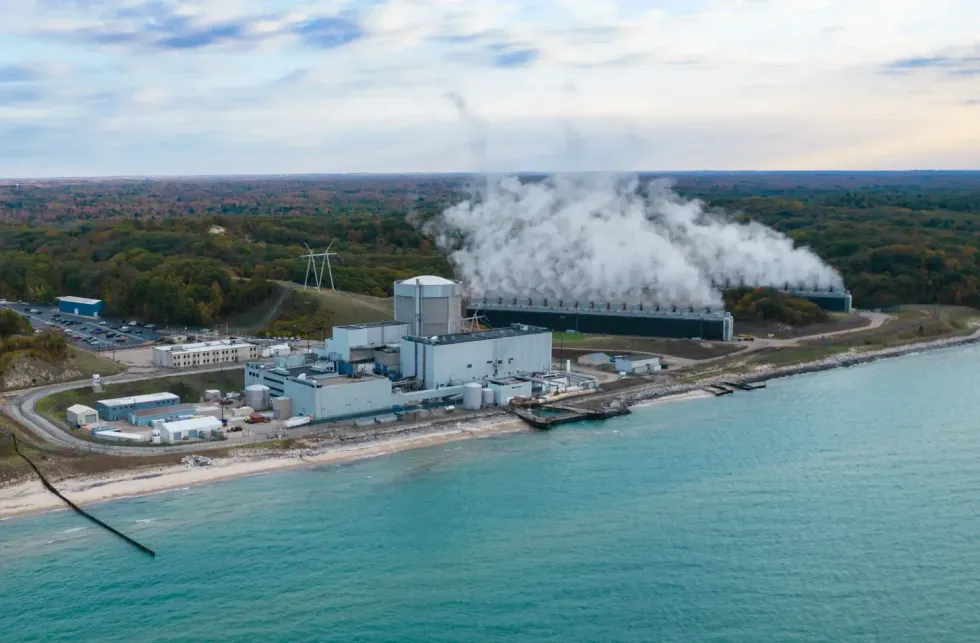Current conditions: The record-setting heat roasting more than 100 million Americans in the central U.S. is now headed for the densely populated Northeast • The American Samoan capital of Pago Pago faces “imminent” flash flooding on Friday amid days of rain • China just set a record for the highest number of hot days since March in its history.
THE TOP FIVE1. U.S. regulators greenlight America’s first nuclear restart

Three years after the Palisades nuclear plant in Michigan became the country’s last atomic power station to permanently close, the facility is set to become the first in U.S. history to reopen after a final shutdown. On Thursday afternoon, the Nuclear Regulatory Commission issued its formal approval for the plant’s operating license, putting the single-reactor station on track to restart later this year, the plant’s owner, Holtec International, told me. With just 11 days to go before its license expired, Palisades’ previous owner opted to close down May 2022 rather than make necessary upgrades to continue operations. The Biden-era Loan Programs Office at the Department of Energy put up more than $1.5 to fund the effort. Despite freezing funding for other projects, the Trump administration shelled out the money to Holtec.
The project still faces obstacles. Holtec still needs to finalize repairs at the plant, which are subject to another NRC review. Anti-nuclear activists, meanwhile, vowed to appeal the NRC license. Still, Holtec’s President Kelly Trice said the NRC approval “represents an unprecedented milestone in U.S. nuclear energy.”
2. China and Europe pledge to go green together as U.S. abandons climate
As the U.S. seeks to dismantle its climate regulations, China and the European Union signed a pledge Thursday to work together on cutting emissions. The document, dubbed “the way forward” following the 10-year anniversary of the Paris climate accords, called the 2015 pact brokered in the French capital “the cornerstone of international climate cooperation” that “all parties” should implement “in a comprehensive, good-faith and effective manner.” The two global powers also reached a deal for the emergency export of rare earth metals from China, which dominates their global trade, to European factories facing shortages of the materials, according to The New York Times.
The diplomatic communique comes as the U.S. goes through the process to quit the Paris Agreement for the second time. In 2017, Trump waited weeks to initiate the exit, and the protocol completed around the time of the 2020 election. That allowed then-President-elect Joe Biden to signal his plans to rejoin immediately, rendering the American withdrawal a brief hiccup. This time, however, the rules allow the U.S. to leave in about a year, and Trump started the process on his first day in office.
Get Heatmap AM directly in your inbox every morning:
3. Trump elevates minerals adviser National Security Council
Just over a week after the Pentagon made a landmark investment in the United States’ only rare earths mine, President Donald Trump elevated his minerals adviser to the Nation Security Council. While the Trump administration did not confirm what Copley’s new position would entail, an industry source told E&E News the job change was a promotion for the military veteran and former mining executive, who would now serve as “both the White House mineral and supply chain czar.”
The move comes as China has sought to leverage its grip over global supplies of minerals such as rare earth metals and graphite by tightening export restrictions. While Trump’s military investment into California rare earth producer MP Materials may mirror China’s strategy of government funding for critical materials, Beijing has another thing going for it: Strong demand from electric vehicles. Therein lies what Heatmap’s Matthew Zeitlin recently called the “paradox” of Trump’s mineral policy: He’s making it easier to mine but eliminating the demand pull of electric vehicles and wind turbines.
4. Google bets big on a CO2 battery startup
Google has invested in small modular reactors, nuclear fusion, and even old-fashioned hydropower to shore up a steady supply of electricity for its reactors. This morning, the tech giant announced a strategic investment into carbon dioxide batteries, as I reported earlier today over at Latitude Media. The startup Energy Dome houses its technology in white, inflatable shelters similar to what you see over the courts at professional tennis tournaments. But inside is equipment that compresses and liquefies CO2, stores it in carbon steel tanks, then turns the liquid back into pressurized gas when energy is needed. Once reheated, the carbon dioxide is pumped through turbines to generate electricity for up to 24 hours at a time.
Headquartered in Milan, Energy Dome already had a deal for pilot plants in Wisconsin, Sardinia, and India, about eight hours west of Hyderabad. But Google said it plans to deploy the technology across the U.S., Europe, and Asia.
5. Maine races to fast-track clean energy before tax credits expire
Maine is speeding up approvals for nearly 1,600 gigawatt-hours of renewable energy to make sure projects can tap into federal tax credits before the Trump administration cracks down, Canary Media’s Sarah Shemkus reported. State regulators gave developers a July 25 deadline to take part in the fast-tracking program. The state is seeking enough bids to meet about 13% of its annual electricity demand. The program will give preference to projects sited on property where water or soil is contaminated by toxic PFAS, the cancer-causing substances known as “forever chemicals.”
Not all states are as welcoming of renewables. In Ohio, as Heatmap’s Jael Holzman reported yesterday, 26 out of 88 counties have “established restricted areas where wind or solar are prohibited.” The key to getting around local opposition is early community outreach and building a base of support for a project.
THE KICKER
Consider the lobster, but listen to the shrimp. A new study in the journal Royal Society Open Science found that listening to the high-frequency sounds snapping shrimp produce “can be used as a real indicator of coral resilience,” Xavier Raick, postdoctoral fellow in bioacoustics at the Cornell Lab of Ornithology, said in a press release. “Snapping shrimp’s abundance is a mirror of coral cover. So if you have more corals, especially very big colonies, you have more snapping shrimps, and then you can use their sound as a proxy for the reef, structure, and health.”
